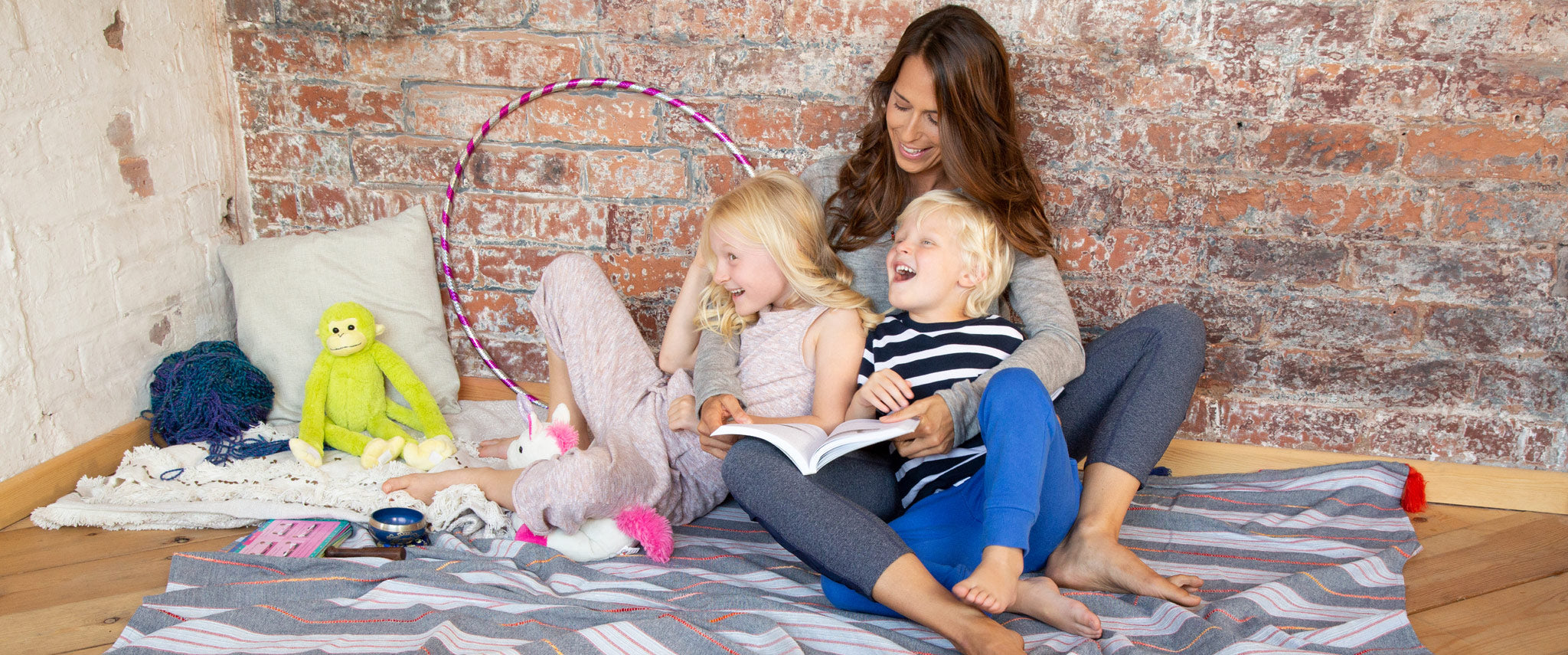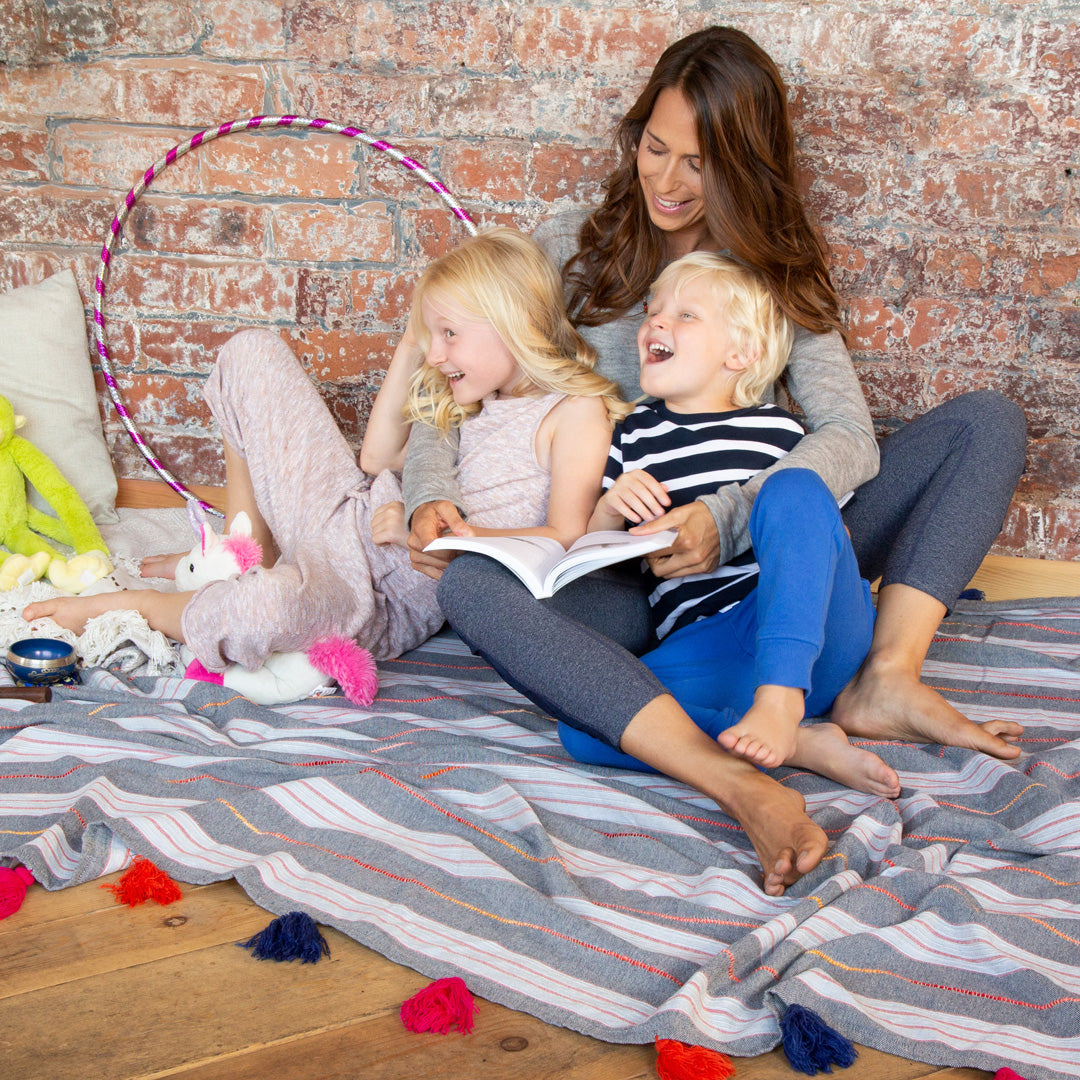Children’s bodies, when feeling frustrated, angry, sad, anxious, etc., respond by producing stress hormones, specifically adrenaline and cortisol. This causes their heart rate to speed up, their back and neck muscles tighten and their breath becomes shallow as blood diverts away from the brain.
Yoga can help to cope with feelings of anxiety and other emotions.
In Yoga, children learn to slow down and become aware of their breath, body, mind, thoughts and emotions. Yoga provides an opportunity for mindfulness and the ability to connect authentically with others. To find out more about the benefits for yoga with kids, please read my blog post “8 Benefits of Yoga for Kids”.

These are the 3 main tools which helps children to deal with stress and anxiety:
1) BREATH WORK/EXERCISE
Talk with your child about breathing in general and how important it is for our organs, muscles and cells. Through conscious breathing in Yoga, we can regulate our mind-body system. We are in control of our breath and can either activate our parasympathetic nervous system by lengthening our exhalations, which calms us. Or, we do the opposite and energise our body by shortening our breaths. The following breathing techniques are ideal for calming and grounding but also for promoting body awareness and encouraging focus.
Bumble Bee Breath
Sit comfortable with your legs crossed and close your eyes. Focus on listening to your breath. Feel the air entering in through you nose, filling up your lungs and blowing out of your mouth.
Now inhale slowly through your nose. Place your fingers gently on your ears to close off external sound. Exhale out through your mouth to “Hummmmmmmmm” as long as possible. Notice the vibration. Repeat. Try a different sound such as “oooohhhhhh”. Repeat this breathing until your body is calmed and relaxed.
Balloon Breath
Sit, stand up tall or lie down. Place your hands gently on the lower belly. Breathe in slowly through your nose to fill your lungs all the way to the top, as you feel your belly and chest expanding. Now slowly breathe out all the air in your lungs, letting your belly sink down flat, as you imagine your balloon belly is shrinking. Repeat at least 4 times.
Back-to-Back Breathing
This is a partner breath exercise that offers an opportunity to connect with your child in a meaningful way. It can be used as a great transition to bedtime, or any time your child needs to calm down.
Sit with your child on the floor back to back. Let the weight of your child’s body push against your body. First, the adult begins by inhaling deeply. The child should feel the expansion in the adults back as he breathes deeply. Now take turns and let the child breath deeply.
Feel the warmth of each others back. Now start breathing together and ask each other what you notice and how it feels.


2) MINDFULLNESS
Being ”mindful” means to pay close attention to what we are doing in the present moment. Mindfulness is all about exploring the present moment and being aware of your senses.
Exploring the “jungle”: take your kids for a walk through the forest and give them the task to spot as many birds, butterflies, bugs and any other animals as they can. Let them carry a little bucket so they can put a stone or leaf in it for each animal they spotted. They will have to focus all of their senses to find them and it will ground them and make them aware of the present moment. Additionally they are in the fresh air and they connect with the nature. At the end of the walk they can count their stones/leaves and try to remember the animals.
Eating with a blindfold
Give your child 3 different food types to taste without touching the food itself (it works great with different pieces of fruit). Ask your child to eat slowly, chew it properly and which flavour they can taste. Let them describe the texture (soft, sour, sweet, squishy for example). Once your child has tasted all three, let them guess which fruit they’ve eaten & ask them to name the fruits in order. Depending on the age of the child, you can add more food to make it a bit more challenging.
Touch meditation
This is a great pre-bedtime activity and can be done in bed. Sit down behind your child and use your index finger to firmly write a letter or shapes on their back, having them guess what you have written or drawn. Depending on the age, you can also write words or even sentences like “Sleep well and sweet dreams”. Don’t forget to take turns!
Gratitude circle
You don’t have to sit in a circle, you can also play this game in the car or on the plane. Ask your child to name something they are grateful for. It could be something in general or something that happened that day. At first, their answers may not be what you would like to hear - “I am so grateful for my new Nintendo Switch” - but as you name your own things you are grateful for, your children will begin to pick up on your values, like friends, peace, health and family.
3) YOGA POSES
In our screen-focused world, children need Yoga more than ever. Yoga enhances flexibility, balance, strength and body awareness. Physical exercise like Yoga poses (Asanas) have positive effects on stress, helping to release endorphins that reduce our feelings of anxiety and also trigger positive feelings. While performing Yoga poses (Asanas), the awareness is on the breath and children learn to integrate the breath with the movement. A child’s yoga practice is a rare opportunity to experience play and focus without worrying about being wrong. It can also be an option for children who fear to fail or being picked last.
1a) Child Pose
How to get into the pose:
- Kneel on your mat and bring your hips back to your heels
- Extend your arms and heart forward and down into the ground
- Allow your forehead and belly to come to the ground too
- Keep your hips back and down toward your feet
- Close your eyes, become soft and still, relax your face, breathe deeply and sink into the earth.
Observe your breath: feel it moving in and out of your nose, feel your belly and chest fill, pressing into the earth and your legs.
Mantra: I am connected
Variation: Bring your arms by the side of your body, fingers toward your toes, palms up.
Adult support: Stand to the side of your child and place your hands on their lower back, hold for a moment. Let your child feel the warmth of your hands and ask them if they would like you to massage their sacrum area.
Benefits:
- Stretches the legs, ankles, thighs, hips, knees
- Releases back and neck tension
- Relieves stress and calms the body
The Tree Pose reminds us that as our roots grow stronger, we can stand tall and stretch our branches to the sky.
How to get into the pose:
- Stand up straight and tall and focus on a non-moving point in front of you.
- Shift your weight to your left foot, lift your right foot up and place it about or below your left knee (never on the knee).
- Bring the palms of your hands together in front of your heart. Breathe.
- If this feels comfortable, then slowly raise your arms over your head.
- Try to look up towards your hands. Close your eyes. You might start to loose your balance. Try again, focus, breathe.
- After a few deep breaths, slowly come out of the position with awareness. Start with returning your hands to your heart and lower your right leg.
- Now do the Tree Pose on the other leg.
Mantra: I am kind, I am balanced.
Variation: Stand next to a wall for support.
Adult support: Try the Tree pose together with your child as you stand next to each other holding hands.
Benefits:
- Improves balance
- Stretches the inner thighs and groin
- Promotes focus and concentration
It is not uncommon for children to experience stress and anxiety during select periods in their lives. Regular Yoga practice and a positive attitude to life's ups and downs can assist with reducing stress, anxiety and tension.


1 comment
Love your ideas, can’t wait to try them with Maeve when she’s a little older.
Any tips for toddlers?